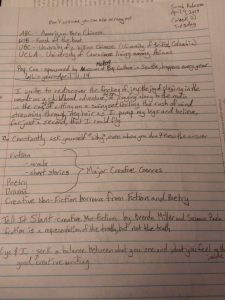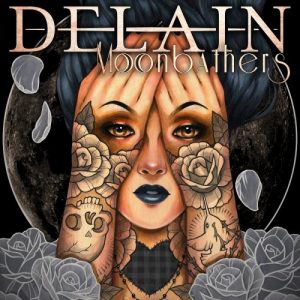
MonthApril 2019
It starts with a steady heartbeat. Then a harp and keyboard introduce themselves softly in the background, leading into the singer’s voice entrancing listeners with its ethereal qualities. Then the chorus hits and she comes to life, emotion evident in the power of her voice. Florence and the Machine’s song Cosmic Love begins, appropriately, with the narrator falling in love. “A falling star fell from your heart and landed in my eyes. I screamed aloud, as it tore through them, and now it’s left me blind.” The “falling star” is the love she feels for the other person and it’s blinded her with the intensity of its metaphorical light. This love is so powerful and overwhelming that no other can compare, hence the lyrics “The stars, the moon, they have all been blown out. You left me in the dark. No dawn, no day, I’m always in this twilight. In the shadow of your heart.” These lyrics are fittingly sung in a way that feels like the singer is screaming with the intensity of her feelings despite still being melodic and ethereal. The drums in the background gives this an orchestral, dramatic quality, made even more emotional by beating to a similar rhythm as a heartbeat. The narrator then becomes quiet and soft once again, preparing herself for disappointment, or perhaps for the feelings to fade unresolved, with the lyrics “I took the stars from our eyes, and then I made a map. And knew that somehow I could find my way back.” But then she seems to realize that her feelings are reciprocated, and the person she’s in love with is just as blinded by love for her as she is for them, as she softly sings “Then I heard your heart beating, you were in the darkness too. So I stayed in the darkness with you.” This leads into the chorus again, but with the new context it feels less despairing and more triumphant, as though saying yes, she was in the darkness caused by the blindness of love, and it was wonderful.
This song is incredibly powerful and thick with emotion. As a child, I had no friends for over a decade. It wasn’t until high school that I was able to make any kind of connection to other people, and even then it almost never lasted. On those rare occasions that the friendship lasted, it was because they clung just as tightly to me as I did to them. To me this song is an excellent representation of the way it feels to shed those feelings of loneliness and hold tight to a relationship, especially when you aren’t sure if the other person even cares about you the way you care about them. For someone who has troubles with keeping friendships, those feelings of uncertainty can be pervasive and ultimately poison the relationship with one or both people’s insecurities. Cosmic Love evokes the feeling of uncertainty that can be typical of starting a new relationship, whether platonic or romantic, while still demonstrating the feelings of love that make us want to take the risk in the first place.

The cover for the symphonic metal band Delain’s album Moonbathers features a pale-skinned woman dominating the image. Her head is contrasted by a dark background, which appears to be a lunar eclipse. The moon is large and as a result the eclipse creates a halo around the woman’s head. Her arms cover most of her face as she places her hands over her eyes. However, her eyes are still “visible” through her arms in the form of tattoos on the backs of her hands, which replace her true eyes. The false eyes are perfectly symmetrical with shapely eyebrows sitting “above” them on her knuckles. The rest of her arms are covered by more tattoos, starting with roses covering her wrists. On her right arm (the viewer’s left) there is a tattoo of an upside-down human skull without a jaw. The skull seems to be peering at the right side of the image. On her left arm (the viewer’s right) there is a tattoo of a hummingbird drinking from the large rose on her wrist. There are tattoos of a rose partially visible on each side of her neck, and in the center of her neck there is an upright, plaid, heart-shaped tattoo which appears to be stitched into her skin. There are groups of roses in the bottom corners of the image which partially conceal the bottoms of the woman’s arms and her shoulders. They are all the same as the woman’s tattoos, only gray roses instead of outlines. Three petals fall around the woman’s head, as gray as the flowers they came from. The only color in the image comes from the woman’s flesh as well as her lips and hair, which are both a dark blue that is so desaturated it’s almost dark gray.
The woman’s mouth is closed, with a slight frown teasing the corners of her lips and making her seem both stately and solemn, impassiveness overtaking any emotion before it can reach the viewer. The hummingbird seems full of life and buzzing with energy, making it seem as though the skull is looking towards it and longing for what it no longer has. By covering her eyes, the woman’s true self is unknown to us; she only allows us to see what she wants us to see. But in doing so, she appears to be blinding herself and is as a result caught between life and death, as she can neither be lively like the hummingbird nor can she be as still as the skull. The roses surrounding the woman are gray, but seem translucent, as though to say that they too, are only shadows of what they used to be, like ghosts who are clinging to life but no longer truly exist. So too, is the moon overtaken by shadows and now exists in an in-between state of there and not-there. The moon, however, is in a transient state. The eclipse will not last forever; there will be an end, and the moon will shine brightly once more with the reflections of the sunlight. There is a hopeful quality to this, as it implies that the woman will similarly break free of the darkness and emerge into the light.
I write to rediscover the feeling of joy. The joy of playing in the woods on a childhood adventure. The joy of singing along to the radio in the car. The joy of sitting on a swing-set feeling the rush of wind streaming through my hair as I pump my legs and believe, for just a second, that I could fly.
- “A 2004 campaign intended to attract Asian and Pacific Islander Americans to McDonald’s saw the launch of a website called “I-am-asian.com,” a phrase McDonald’s also claims to have trademarked as an intellectual property…” (Alien Encounters, pgs. 13-14)
- This astounded me when I read it. Wouldn’t trademarking that phrase imply that only McDonald’s owned the right to state that you are Asian, so they could potentially sue people or television shows or whatever if they said it? (As in, claiming that a show used their “intellectual property” if a character said “I am Asian”.) Can they even do that? This article says that this happened in 2004, was there any backlash at the time? It doesn’t mention anything further about that.
- “…some Asian American cultural producers have had to confront the conflict between their “oppositional” practices, which attempt to break down discourses about their inherent exoticness, and the transmission of these practices in a market that capitalizes on those very ideas of otherness.” (Alien Encounters, pg. 15)
- My understanding of this is that even if Asian Americans are making things that are trying to humanize and normalize Asians in American culture, they’re still participating in a system that fetishizes and dehumanizes them. Does this mean that the authors are saying that, in order to create change in a system, you have to become complicit in the system that you’re trying to change?
- “Asian American music critics… find themselves responding again and again to suggestions that Asian Americans don’t listen to or are not “able” (or “real” enough) to make indie rock, punk, or hip hop music.” (Alien Encounters, pg. 16)
- This made me think about how important representation in media is, and how it normalizes things that might have seemed strange to people who would otherwise only be familiar with stereotypes. I grew up watching American Dragon: Jake Long, which was a Disney Channel cartoon in the early 2000’s. The main character, Jake Long, was a Chinese American who lives in New York. In the show, he was often portrayed as listening to a lot of hip hop and other music that tends to be associated more with African American culture than with Asian American culture, but because I grew up watching this show, it never occurred to me to think it was “strange” that he didn’t fit into a stereotype of an Asian person.
- “These new technologies emerged in tandem with what we alluded to earlier as a particularly Asian cybernetic imaginary. Beginning in the 1980s, the threatening specter of the mechanistic, and supposedly “soulless,” Japanese (on whom, of course, the “greatest” technological weapon of World War II was unleashed by the United States in the form of the atomic bomb) began to cast its shadow on American culture. Apparent admiration for “Japanese efficiency” slid easily, and quietly, into fears of a hyperrationalized, corporate empire of the rising sun.” (Alien Encounters, pg. 27)
- Why were these fears developing in the 1980s as opposed to during or immediately after World War II, when we were at war with them? What was going on in the world at the time that could have caused or contributed to people fearing a corporate Japanese empire?
© 2025 Sarah's A-POP Blog
Theme by Anders Norén — Up ↑
